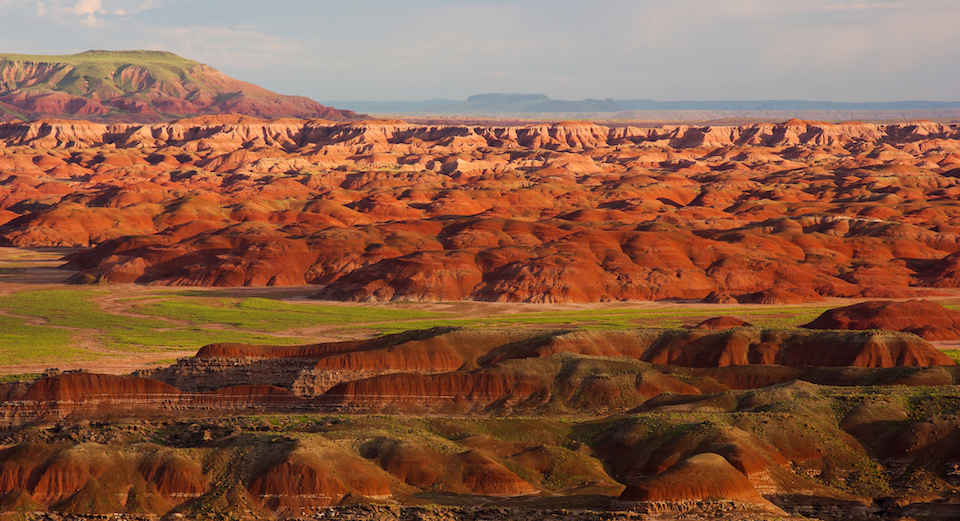
Red badlands with grassy lowlands in the Petrified Forest National Wilderness Area, within Petrified Forest National Park/NPS, Stuart Holmes
The National Park System covers more than 85 million acres, and it's possible that some of those acres are hard, if not impossible, to access because they are surrounded by private lands or have been restricted for some other reason. With your help, the National Park Service wants to compile a list of those hard-to-reach lands that are part of a national park.
Once that list is in hand, the Park Service intends to see how it can increase access to those places. This effort, according to the agency, advances the John D. Dingell Jr. Conservation, Management, and Recreation Act, which was signed into law by President Donald Trump in March 2019.
“Increasing the public’s awareness and access to the more than 85 million acres managed by the National Park Service is one of our top priorities,” said de facto National Park Service Director David Vela. “We’re looking forward to working with the public, partners, and stakeholders to identify areas with no or restricted access to national park areas and collaborate with landowners to establish avenues for public enjoyment of these lands.”
Section 4105 of the Dingell Act instructs the NPS and other federal land management agencies to develop a priority list of lands with no or restricted public access that meet a set requirements and considerations. In the coming months, the Bureau of Land Management and the U.S. Fish and Wildlife Service will also seek the public’s input to nominate lands within their jurisdictions under similar criteria.
NPS’s final priority list will be posted online by March 12, 2020, and updated biennially thereafter for 10 years.
Share Your Recommendations
Public comments will be accepted through January 4, 2020, via the NPS’s Planning, Environmental and Public Comments website.
Nominated lands must meet the following requirements and considerations:
-
Must be managed by the NPS.
-
Must be at least 640 contiguous acres.
-
Must have significantly restricted or no public access.
-
Potential for public access and the likelihood of resolving the absence of, or restriction to public access, are among other criteria for consideration.
-
For example, if a sizable parcel of NPS land is completely surrounded by privately owned land with no or restricted public access, the NPS may consider adding this to the priority list and begin working with states, local governments, nonprofit organizations and/or property owners to acquire land or other means of access to the NPS land, ensuring its long-term protection.
-
Recommendations must include the following information:
-
Location of the land or parcel.
-
Total acreage of the land or parcel.
-
Description or narrative about the land’s restricted or complete lack of access.
-
Any additional information the NPS should consider when determining if the land should be on the NPS’s priority list.



Comments
This needs to be done. I'm not against private inholdings in/around our great National Parks. Often times these inholdings pre-date the parks. Now that the parks/wilderness are there, public access issues gets interesting in regards to thsee private inholdings. It is my hope that once permanent funds are allocated to the LWCF 'Land and Water Conservation Fund' public access to these public lands can be addressed with the local landowners.
Smells like "Compile this list so the Federal land managers can offload these isolated parcels to a more extractive managing agency." Spend money to increase access when we can't maintain the lands we already have access to?? Sure...
This is how bad things have gotten. The laundry list excerpted here, it seems to me, is a classic, progressive resource-management prototype in full accord with Park Service principles. But as Parkster suggests, nothing is as it seems anymore -- and so one is instantly skeptical of a sudden concern for "the visitor experience" in remote landscapes, while backlogs and closures in existing units are unfunded, and resource extraction in surrounding areas is not simply permitted but abetted by sibling agencies. It seems to me ...
The current NPS Deputy Director, as Kurt Repanshek has reported, is known for the kind of decisionmaking that might incline one to agree with Parkster's comment above. Is that okay to say? https://www.nationalparkstraveler.org/2018/09/peer-questions-david-velas...